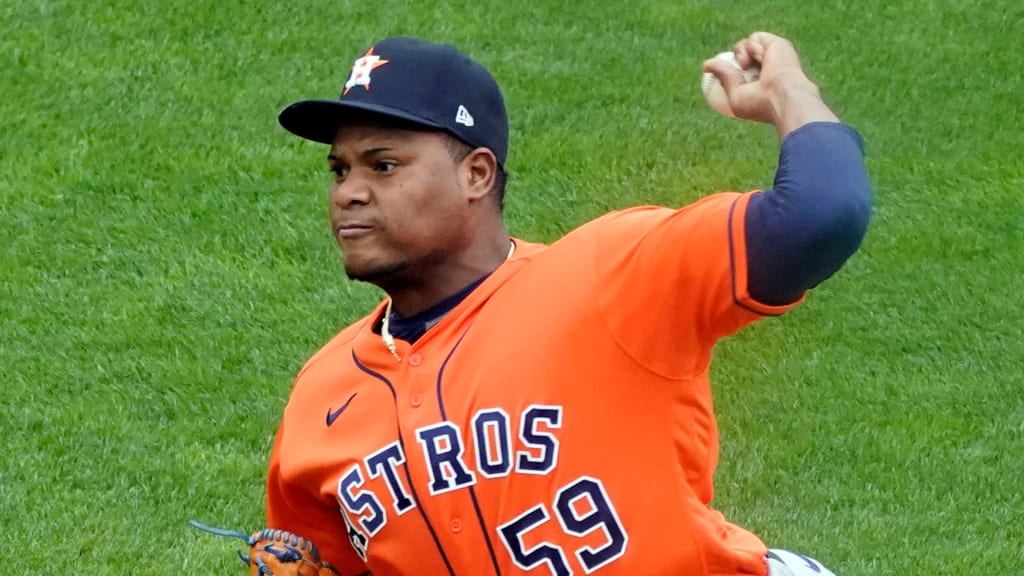
You can take the Astros’ blueprint for success in sweeping the Twins in the American League Wild Card Series last week and file it away. Astros’ starting pitchers -- and starters pitching in relief -- combined to throw 16 1/3 of their 18 innings of work in the two-game series, with Framber Valdez (five innings in Game 1) and Cristian Javier (three innings in Game 2) dealing in scoreless relief.
Facing the possibility of playing five games in five days in the AL Division Series, which begins Monday with Game 1 against the A’s at Dodger Stadium, the Astros will have to switch gears. They’ll have to depend on their bullpen arms to cover the bulk of the relief innings. There are no travel days between games, and the path to 27 outs each day could be a challenge for a relief corps that ranked 15th in MLB in ERA (4.39) and was second in blown saves (14).
“We’ve got to show faith and confidence in whoever we have,” Astros manager Dusty Baker said. “Some guys’ leashes are longer than others, so we just go game to game and not worry about it.”
Valdez will start one of the team’s three guaranteed games in the Division Series and could be their Game 1 starter on Monday. That could conceivably allow him to start Game 5 on short rest, but he won’t be available in relief. For a lefty, Valdez is very effective against right-handers (.641 opponents’ OPS) and matches up well against Oakland, a predominantly right-handed-hitting team
Zack Greinke, Jose Urquidy and Lance McCullers Jr., who didn’t start in the Wild Card Series, are in the pool of starters rested and ready for the Division Series. Javier, the fifth starter, could be used in relief at some point to get a Game 5, if needed.
The Astros avoided using relievers more than two games in a row during the regular season. They were weary of the workloads of rookies like Enoli Paredes, Andre Scrubb and Blake Taylor, who wound up on the injured list late in the season. The one reliever the Astros will not shy away from throwing as much as necessary is closer Ryan Pressly, who worked back-to-back games eight times this year, including both ends of a doubleheader Aug. 23 against the A’s, during which he had two saves.
Among their seven relievers who threw the most innings -- Scrubb, Taylor, Parades, Pressly, Brooks Raley, Josh James and Cy Sneed -- only three worked back-to-back games more than twice. Pressly threw consecutive games eight times, posting a 2.45 ERA. Paredes did it five times, posting a 2.25 ERA. And Taylor did it four times, not allowing a run. Scrubb (5.40 ERA), Raley (0.00) and Sneed (5.40) threw back-to-back games twice, and James (0.00) once.
“It’s all hands on deck, obviously,” Pressly said. “It’s a five-game series. There aree no off-days. We’re going to have to push ourselves further than we’ve ever had, especially these young guys who are in the 'pen with me. They’re eager to get out there, they’re excited, and I know they’re ready to take the ball.”
One challenge unique to Houston’s bullpen is that so many of their arms were starters in the Minor Leagues.
Raley was a starter in Korea the previous five years; James began this year in the rotation and Paredes, Sneed and Luis Garcia were starters, too, in the Minors. Taylor made the full-time switch to starter only last year. Injuries devastated Houston’s bullpen early in the season, forcing the Astros to find healthy arms from their Minor League system. Of the 15 rookie pitchers who threw this year, 10 made their Major League debuts.
“We’re very conscious of not using their arms because they’re not used to it,” Baker said. “Now, all of a sudden, we’re asking them to relieve. It made it hard on me not to have a guy available. Half the time, they weren’t ready two days in a row. We just have to try to mix and match and do what we’ve got to do.”
